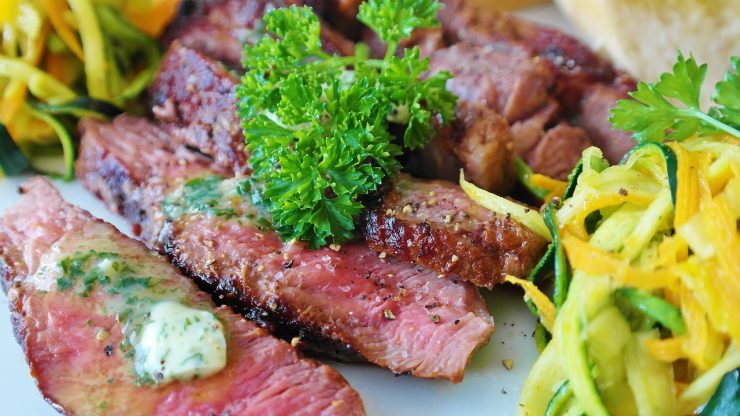What’s the Deal with the Carnivore Diet? Here’s What I’ve Learned…
You’ve probably seen the buzz over the past couple of years—carnivore diets are catching on, and the results people are sharing can be pretty surprising. I get it—it sounds totally backwards compared to what we’re usually told by mainstream media and health “gurus.”
Take Joe Rogan, for example. He tried the carnivore diet for a full month back in 2020 and said it was the best he’s ever felt. He lost 12 pounds of body fat, finally got rid of his love handles, and said his energy was rock solid all month long. He felt so good that he did it again the next January—and had similar results.
Now, before you think this is just another diet fad, I’d invite you to keep an open mind. A lot of what we hear about nutrition in the media is influenced by big food companies selling ultra-processed “plant-based” products. These companies want you to avoid animal foods, because that’s how they make money. The more you cut out meat, the more processed stuff they can sell you.
But when you look into the actual science (not just headlines), the story gets a lot more interesting. In this post, I’ll walk you through what I’ve learned about carnivore diets—and why they work so well for some people.
So What Is the Carnivore Diet?
In simple terms, it’s a way of eating that focuses mostly—or entirely—on animal-based foods: meat, fish, eggs, and sometimes dairy. Some people eat zero plant foods, while others eat small amounts of the least problematic ones—mainly low-toxicity fruits.
On the flip side, foods like leafy greens, nightshades, grains, and legumes are often avoided because of their higher levels of antinutrients or plant toxins. (Don’t worry—I’ll explain more about that below.)
I’ve been diving deep into this topic for several years now, and I’m blown away by how many people are seeing huge health improvements. Of course, like any diet, it doesn’t work the same for everyone. But there are a few groups of people who seem to benefit the most.
Who Can Benefit from a Carnivore or Animal-Based Diet?
1. People with Autoimmune Conditions
Many people with autoimmune diseases report dramatic improvements—or even full remission—when switching to carnivore. It’s essentially the ultimate elimination diet, cutting out common triggers like gluten, lectins, oxalates, and nightshades.
It’s not uncommon for people to find out that foods like beans, leafy greens, or tomatoes were quietly flaring up their symptoms all along.
2. People with Gut and Digestive Issues
This one surprises a lot of people, but reducing fiber and plant antinutrients can actually help digestion for some folks. Even gut-health expert Dr. Michael Ruscio has said that the majority of his patients need less fiber—not more.
Too much fiber can cause bacterial overgrowth, bloating, and irritation in the gut. I personally know people with Crohn’s disease who saw better results from carnivore than from anything else they’d tried. Of course, this isn’t mainstream advice (yet), so don’t expect your doctor to be on board—most haven’t even heard of it.
3. People with Obesity or Type 2 Diabetes
Low-carb diets have been proven to help with blood sugar control, and carnivore takes that concept to the extreme. It’s especially helpful for diabetics or those with insulin resistance. And when it comes to weight loss, meat is super satiating—it’s really hard to overeat steak. But try stopping at one slice of pizza or one bowl of mac and cheese? Good luck.
Personally, I’ve been eating a mostly animal-based diet (around 85–90% carnivore) for the last three years. I include a few low-toxicity plants like fruit, squash, avocado, and the occasional sweet potato or spoon of honey. My digestion is smooth, energy is steady, and my bloodwork has been fantastic.
Wait… Isn’t Meat Supposed to Be Bad for You?
Not necessarily. The idea that cholesterol and saturated fat cause heart disease is outdated. In fact, animal foods contain nutrients that support heart health—things like vitamin K2, DHA, carnosine, and more.
The real culprits? Seed oils (like canola, soybean, sunflower) and refined sugar. These are the things that wreak havoc on metabolic and cardiovascular health—not steak.
And get this: red meat is less inflammatory than chicken or pork. That’s because chicken and pork are fed mostly grains and soy, which increases their omega-6 content—about 10x more than red meat. Beef, lamb, and bison eat mostly grass, making their fat profile a lot healthier.
So, What Do I Eat?
Here’s a quick look at my typical week:
-
Daily: Grass-fed beef, bison, lamb, yak
-
A few times a week: Wild fish and shellfish, eggs
-
Plant foods: Avocado, cucumbers, squash, sweet potatoes (occasionally), coffee, wine, and fruit (only in-season)
-
Treat: A small spoon of honey now and then
I mostly avoid chicken and pork because of their higher omega-6 levels.
What About Veggies?
Hot take: I think a lot of vegetables actually do more harm than good, depending on your body. Based on genetic factors and certain health conditions, some veggies can be problematic:
-
Brassicas (like broccoli) can mess with your thyroid.
-
Nightshades (tomatoes, eggplant, potatoes) can aggravate joint pain.
-
Leafy greens are high in oxalates and can contribute to kidney stones.
-
Beans are full of lectins that irritate digestion.
Personally, cutting out most veggies and beans had the biggest positive impact on how I feel. It’s not just me—many hunter-gatherer diets around the world were meat and fruit-heavy, with very few leafy greens. Wild leaves are often bitter or toxic and offer very little in terms of calories, so our ancestors didn’t bother much with them.
Men vs. Women: Do Carnivore Diets Work Differently?
From what I’ve seen, most men thrive on carnivore-style eating. Women, on the other hand, seem more split—some do great, others feel better with more fiber and plants in their diet. This lines up with how ancestral roles were divided: men hunted and ate more meat, while women gathered more plant foods.
Final Thoughts
One of my good friends, Dr. Paul Saladino (author of The Carnivore Code), has been thriving on a mostly carnivore diet for years—just meat, organs, honey, and fruit. Before that, he was vegan and it wrecked his health. The contrast is wild.
I always encourage people to be curious and open-minded when it comes to nutrition. There’s a lot of bias out there, especially in the plant-based world. But whether you lean toward animal-based or plant-based eating, it’s important to focus on quality, avoid the most damaging processed foods (like seed oils and sugar), and listen to your body.
Some people might do best with a seasonal approach—leaning more carnivore in the winter and adding more plants when fruits and roots are naturally in season. Either way, a thoughtful, less-dogmatic approach to food usually wins.











